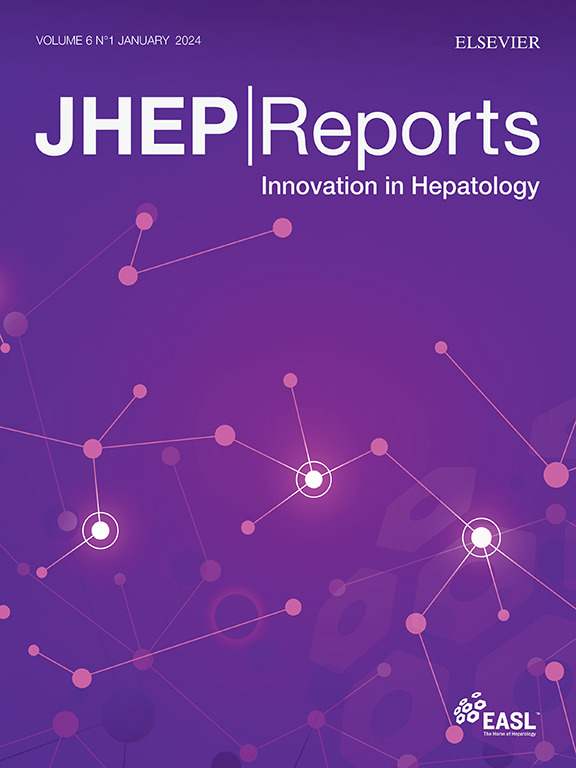Temporal dichotomy of neutrophil function in acute liver injury and repair
IF 7.5
1区 医学
Q1 GASTROENTEROLOGY & HEPATOLOGY
引用次数: 0
Abstract
Background & aims
Acetaminophen (APAP)-induced acute liver injury (APAP-ALI) is the leading cause of acute liver failure-induced death, with host innate immune responses driving outcomes. Neutrophils are activated and increased in APAP-ALI and reported to contribute to liver damage. However, neutrophil dysfunction in patients with acute liver failure is associated with non-survival, and recent reports highlight their importance in hepatic repair. Neutrophil-targeted therapies for APAP-ALI are hampered by this controversy and a lack of time-dependent investigation.
Methods
Hepatic neutrophils were depleted at different times in a wild-type mouse model of APAP-ALI. Fpr1-/- mice, with reduced neutrophil activation, were also used. The impact of neutrophil depletion was interrogated during hepatic injury and repair after APAP-ALI, using serum biochemistry, liver and blood flow cytometry, liver histopathology, immunohistochemistry, ELISA, and NanoString analysis.
Results
Neutrophils contributed both to hepatic damage and repair after APAP-ALI. Early liver necrosis was reduced by neutrophil depletion (34% to 23%, p = 0.0018, n ≥10) and by reducing neutrophil functions (39% to 29%, p = 0.0279, n ≥11). By contrast, late neutrophil depletion resulted in markedly reduced liver repair (persistent necrosis 17% to 30%, p = 0.016, and higher serum alanine aminotransferase [1,221 to 3,725 IU/l, p = 0.0007, n ≥10]) and hepatocyte proliferation (decreased minichromosomal maintenance 2+ hepatocytes, 3% to 1%, p = 0.025, n = 10). Late neutrophil depletion reduced proliferation, growth factors, and angiogenesis transcripts (Mik6 fold change [FC] -6.322, p = 0.002; Socs2 FC -2.91, p = 0.01; vascular endothelial growth factor A FC -1.48, p = 0.01; n = 3). Similar transcript changes were identified when preventing formylated peptide receptor 1-mediated neutrophil activation, along with reduced extracellular matrix remodeling (Col12a1, FC -1.99, p = 0.0001; n ≥5). Finally, depleting neutrophils resulted in a hepatic proinflammatory monocyte/macrophage phenotype during repair stages, with increased proinflammatory-related transcripts and reduced reparative transcripts.
Conclusion
Recruited neutrophils contribute not only to hepatic damage early in APAP-ALI, but also to hepatic repair through a variety of pathways, including extracellular matrix remodeling, angiogenesis, hepatocyte proliferation, and promotion of an anti-inflammatory monocyte/macrophage phenotype.
Impact and implications
Novel therapies are required for APAP-ALI to improve patient outcomes. Neutrophil products and functions are potential targets for future therapies, but current literature controversy and a lack of time-dependent studies hinder progression. This study resolves the literature controversy, showing that neutrophils have time-dependent dichotomous roles in APAP-ALI. These insights highlight that early neutrophil-targeted interventions to reduce liver damage could be detrimental to subsequent patient recovery. Therefore, future research should aim to either elucidate isolated damaging functions or harness reparative functions of neutrophils for late-stage novel therapies for APAP-ALI.

急性肝损伤与修复中中性粒细胞功能的时间二分法
背景,乙酰氨基酚(APAP)诱导的急性肝损伤(APAP- ali)是急性肝衰竭诱导死亡的主要原因,宿主先天免疫反应驱动结果。中性粒细胞在APAP-ALI中被激活和增加,并被报道有助于肝损伤。然而,急性肝功能衰竭患者的中性粒细胞功能障碍与无法生存相关,最近的报道强调了它们在肝修复中的重要性。中性粒细胞靶向治疗APAP-ALI受到这一争议和缺乏时间依赖性研究的阻碍。方法在APAP-ALI野生型小鼠模型中,对不同时间的肝中性粒细胞进行损耗。中性粒细胞活化降低的Fpr1-/-小鼠也被使用。通过血清生化、肝脏和血流式细胞术、肝脏组织病理学、免疫组织化学、ELISA和NanoString分析,研究了中性粒细胞耗损在APAP-ALI后肝损伤和修复过程中的影响。结果中性粒细胞对APAP-ALI术后肝损伤和修复均有促进作用。中性粒细胞耗竭(34% ~ 23%,p = 0.0018, n≥10)和中性粒细胞功能降低(39% ~ 29%,p = 0.0279, n≥11)可减轻早期肝坏死。相比之下,晚期中性粒细胞耗损导致肝修复(持续性坏死17% ~ 30%,p = 0.016,血清丙氨酸转氨酶升高[1,221 ~ 3,725 IU/l, p = 0.0007, n≥10])和肝细胞增殖(小染色体维持2+肝细胞减少,3% ~ 1%,p = 0.025, n = 10)显著降低。晚期中性粒细胞耗竭降低增殖、生长因子和血管生成转录物(Mik6折叠改变[FC] -6.322, p = 0.002;Socs2 FC -2.91, p = 0.01;血管内皮生长因子A FC -1.48, p = 0.01;N = 3)。当阻止甲酰化肽受体1介导的中性粒细胞活化,以及减少细胞外基质重塑时,发现了类似的转录物变化(Col12a1, FC -1.99, p = 0.0001;n≥5)。最后,在修复阶段,中性粒细胞的消耗导致肝脏促炎单核细胞/巨噬细胞表型,促炎相关转录物增加,修复转录物减少。结论募集的中性粒细胞不仅参与APAP-ALI早期肝损伤,还通过多种途径参与肝修复,包括细胞外基质重塑、血管生成、肝细胞增殖和促进抗炎单核/巨噬细胞表型。影响和意义APAP-ALI需要新的治疗方法来改善患者的预后。中性粒细胞产物和功能是未来治疗的潜在靶点,但目前的文献争议和缺乏时间依赖性研究阻碍了进展。本研究解决了文献争议,表明中性粒细胞在APAP-ALI中具有时间依赖性的二元作用。这些见解强调,早期以中性粒细胞为目标的干预措施减少肝损伤可能不利于随后的患者康复。因此,未来的研究应着眼于阐明孤立的损伤功能或利用中性粒细胞的修复功能来治疗APAP-ALI的晚期新疗法。
本文章由计算机程序翻译,如有差异,请以英文原文为准。
求助全文
约1分钟内获得全文
求助全文
来源期刊

JHEP Reports
GASTROENTEROLOGY & HEPATOLOGY-
CiteScore
12.40
自引率
2.40%
发文量
161
审稿时长
36 days
期刊介绍:
JHEP Reports is an open access journal that is affiliated with the European Association for the Study of the Liver (EASL). It serves as a companion journal to the highly respected Journal of Hepatology.
The primary objective of JHEP Reports is to publish original papers and reviews that contribute to the advancement of knowledge in the field of liver diseases. The journal covers a wide range of topics, including basic, translational, and clinical research. It also focuses on global issues in hepatology, with particular emphasis on areas such as clinical trials, novel diagnostics, precision medicine and therapeutics, cancer research, cellular and molecular studies, artificial intelligence, microbiome research, epidemiology, and cutting-edge technologies.
In summary, JHEP Reports is dedicated to promoting scientific discoveries and innovations in liver diseases through the publication of high-quality research papers and reviews covering various aspects of hepatology.
 求助内容:
求助内容: 应助结果提醒方式:
应助结果提醒方式:


